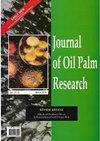EXPERIMENTAL INVESTIGATIONS ON TRIBOLOGICAL ASSESSMENT AND NOx EMISSIONS OF PALM BIODIESEL BLENDED WITH OLEIC ACID AND ETHANOL
IF 1.3
4区 农林科学
Q2 Agricultural and Biological Sciences
引用次数: 0
Abstract
Tribological behaviour of biodiesel should be investigated to get confidence for long-term engine usage. Also, the higher nitrous oxide (NO x ) level from the biodiesel-fueled engine is observed. Tribological assessment and engine performance of lower blends of palm biodiesel (B10, B20) are available in the literature. Due to limited reserves of fossil fuels, the demand for biodiesel is increasing day by day. To fulfil this demand, the higher blends of biodiesel (such as B80, B90) should be investigated. Hence, this study aimed to investigate the tribological and NO x assessment of the higher blends of palm biodiesel. Palm biodiesel was produced by transesterification and blended with oleic acid (OA) and ethanol (E). Biodiesel blends such as 100% biodiesel (B100), 80% biodiesel + 20% oleic acid (B80OA20), 90% (80% biodiesel + 20% oleic acid) + 10% ethanol (B80OA20E10), 90% biodiesel+10% oleic acid (B90OA10), and 95% (90% biodiesel + 10% oleic acid) + 5% ethanol (B90OA10E5) were prepared. Pin on disc machine was used for tribological study and diesel engine was used for NO x analysis. Nearly 40% reduction in wear and 48% reduction in friction were observed for B80OA20 compared to B90OA10, while B90OA10E5 exhibited the lowest frictional force among all the test fuels. During tribological assessment, two blends B80OA20 and B80OA20E10 showed satisfactory performance and were further studied for NO x analysis. Also, these two blends lower NO x emissions by 12% and 2%, respectively, compared to B100.掺有油酸和乙醇的棕榈生物柴油的成分分析和氮氧化物排放实验研究
本文章由计算机程序翻译,如有差异,请以英文原文为准。
求助全文
约1分钟内获得全文
求助全文
来源期刊

Journal of Oil Palm Research
农林科学-食品科技
CiteScore
2.60
自引率
30.80%
发文量
69
审稿时长
>12 weeks
期刊介绍:
JOURNAL OF OIL PALM RESEARCH, an international refereed journal, carries full-length original research papers and scientific review papers on various aspects of oil palm and palm oil and other palms. It also publishes short communications, letters to editor and reviews of relevant books. JOURNAL OF OIL PALM RESEARCH is published four times per year, i.e. March, June, September and December.
 求助内容:
求助内容: 应助结果提醒方式:
应助结果提醒方式:


